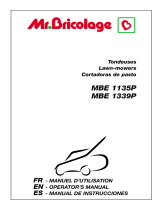
Switching the engine off
Move the throttle control (item 3) to min.,
release brake bar A and wait, until the
engine has come to a complete stop.
Note: Releasing the brake bar short-circuits the
electronic engine ignition, and the engine and
consequently the cutting blade are brought to a
complete stop in a few seconds.
Information about mowing
When mowing, observe all safety
instructions at the beginning of these
operating instructions.
Mowing with grass catcher
The grass catcher (item 6) handles short and dry grass
very well.
Please note:
- The shorter the cuttings, the better the grass catcher
handles them;
- Long or wet cuttings could possibly clog up the
discharge/catcher.
Quality of cut
Grass length, density and moisture content determine
the quality of cut. Dry and reasonably short grass
provides ideal conditions for a clean cut. Wet grass may
also be mown and collected, but quality cut and
collection efficiency suffer. A sharp blade is a must for a
clean, perfect cut. A blunt blade (grass blades fray
when cut, the lawn turns yellow) must be sharpened
(see chapter "Blade"). Mow at a steady pace, in as
straight a line as possible; cut strips should overlap by a
few centimetres, which results in a clean pattern. In
case of long grass, first cut with a higher setting in one
direction and then across the first pattern with the
standard cutting height (Fig. 10).
Lawn care
Note: If, on account of the growth pattern,
the full engine power is not required, you
can select the Eco position between max.
and min. on the throttle control (Fig. 6) to
protect the environment.
If possible, mow only when the lawn or ground is dry.
When the ground is damp, the wheels press into the
turf and leave tracks behind. The more frequently a
lawn is mowed (ideally every week), the better and
more even its appearance. Frequent cutting encourages
growth in the blade, making it more resistant. Short
cuttings up to approx. 1 cm in length can be left on the
lawn; collect longer cuttings with the grass catcher. In
spring, make the first cut and clean the lawn approx. 2
– 3 weeks before growth really starts. To encourage
your lawn to turn green early, cut only approx. 1.5 cm
of dormant grass. Before mowing, search the lawn for
debris (stones, shards, metal objects, etc.). An additional
cleaning (leaves, etc.) can be effected via the grass
catcher.
Never cut thin or young lawn too short (3 – 4 cm blade
height). Maintain this cut for 4 – 5 weeks to encourage
the lawn to grow horizontally and to gain density.
Never cut your lawn too short in the dry and hot season
to prevent it from drying out or becoming parched.
Note: SOLO lawnmowers with rear discharge are
particularly suitable for collecting autumn leaves.
However, do this
only on lawn areas. Collecting leaves
on solid ground (e.g. roads and paths) is not permitted
because of the associated safety hazards. Note: For
collecting leaves, set the cutting height to medium or
high (item 13).
Maintenance and care
For your personal safety, always remove the
spark plug (item 11) cap before any
maintenance or cleaning work. Any work
beyond that described as maintenance and
care should be carried out by your local
authorised service workshop.
Cleaning the mower
Thoroughly clean the mower after every use;
particularly underneath the cutting deck, the blade and
the area surrounding the blade. After releasing the
star-shaped handles, the mower can be positioned for
cleaning on its rear wheels and be supported by the
lower handle (Fig. 11). First remove the spark plug cap
and either use up all fuel or drain it. Catch any fuel
which may escape from the carburettor with a rag. Dirt
and grass cuttings are easiest removed straight after
mowing has been finished. Stubborn grass residues and
dirt deposits underneath the mower deck impair the
grass discharge and reduce the cutting quality. Any dirt
deposits on the blade and impeller cause imbalance and
therefore vibrations. Also check that the airflow from
the vacuum fan (turbo effect) supporting the discharge
is not impaired by grass residues.
You can clean the discharge chute with a small stick or
screwdriver.
Never clean the mower with a water hose or high
pressure cleaner. The engine should always stay dry. The
outer deck components can easily be kept clean with a
cloth. Never use aggressive cleaning agents, such as
cold cleaning fluids or "thinners".
From time to time (at least annually), lightly lubricate
wheel axles and hubs with grease. For this, remove the
wheel covers, release the screw and pull the wheel off
its axle. During dismantling, observe the order of the
individual components (Fig. 12).













